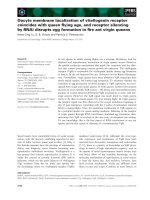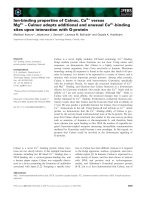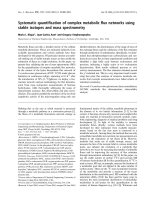Báo cáo khoa học: "Axillary bud proliferation of 2 North American oak species: Quercus alba and Quercus rubra" ppsx
Bạn đang xem bản rút gọn của tài liệu. Xem và tải ngay bản đầy đủ của tài liệu tại đây (308.39 KB, 4 trang )
Original
article
Axillary
bud
proliferation
of
2
North
American
oak
species:
Quercus
alba
and
Quercus
rubra
OJ
Schwarz
SE
Schlarbaum
1
Department
of
Botany,
The
University of
Tennessee,
Knoxville,
TN,
37996-1100;
2
Department
of
Forestry,
Wildlife
and
Fisheries,
Agricultural
Experiment
Station,
The
University
of
Tennessee,
Knoxville,
TN,
37901-1071,
USA
Summary —
Quercus
alba,
white
oak,
and
Quercus
rubra,
northern
red
oak,
were
selected
to
devel-
op
in
vitro
plantlet
regeneration
methods
from
bud
and
embryo
explants.
Various
hormonal
combina-
tions
were
applied
to
explants
to
induce
axillary
bud
proliferation.
Maximal
multiple
shoot
production
was
obtained
when
an
intermediate
micromolar
range
of
benzyladenine
(0.44-4.44
μM)
was
applied
alone
or
in
combination
with
low
concentrations
of
naphthaleneacetic
acid
(1.0-100
μM).
In
vitro
rooting
of
1
Q
alba
microshoot
was
accomplished.
axillary
bud
proliferation
/
Quercus
/ in
vitro
/ regeneration
Résumé —
Prolifération
de
bourgeons
axillaires
de
2
chênes
nord-américains,
Quercus
alba
et
Quercus
rubra.
Des
méthodes
de
multiplication
in
vitro
à
partir
de
bourgeons
ou
d’embryons
ont
été
développées.
De
nombreuses
combinaisons
hormonales
ont
été
testées
pour
induire
la
proliféra-
tion
de
bourgeons
axillaires
chez
les
explants.
Les
meilleurs
résultats
ont
été
obtenus
avec
une
so-
lution
micromolaire
de
benzyl
adénine
variant
de
0,44
μM
à
4,44
μM
appliquée
seule
ou
en
mélange
avec
de
l’acide
naphtalèneacétique
(1,0-100
μM).
L’enracinement
in
vitro
de
microplants
de
Q
alba
a
été
obtenu.
prolifération
de
bourgeons
axillaires
/Quercus
/in
vitro
/ régénération
INTRODUCTION
The
genus
Quercus
contains
some
of
the
most
commercially
important
hardwood
species
in
the
world.
In
North
America,
Quercus
alba
L,
white
oak,
and
Quercus
rubra
L,
northern
red
oak,
are
the
2
most
valuable
oak
species
used
by
the
lumber
and
furniture
industries.
Veneer
quality
trees
command
a
premium
price
and
are
a
significant
commodity
in
the
wood
export
market.
Clonal
propagation
of
valuable
trees
is
being
explored
in
a
number
of
species.
The
genetic
fidelity
of
clones
make
them
of
potential
value
for
a
variety
of
purposes,
ranging
from
research
on
genotype
x
envi-
ronmental
interaction
to
increasing
com-
mercial
yields.
Quercus
species,
however,
have
had
a
relatively
small
role
in
clonal
forestry
because
they
are
difficult
to
vege-
tatively
propagate.
Two
commonly
used
sources
of
explant
material,
rescued
em-
bryos
and
buds,
both
terminal
and
lateral,
from
young
seedlings,
were
used
to
devel-
op
in
vitro
axillary
bud
proliferation
sys-
tems
for
Q
alba
and
Q
rubra.
MATERIALS
AND
METHODS
Plant
materials
Quercus
rubra
acorns
were
obtained
from
bulked
collection
made
in
the
Shawnee
National
Forest
in
southern
Indiana,
USA,
and
stratified
for
90
days
prior
to
embryo
removal.
Seedlings
of
Q
alba
were
from
bulked
acorns
obtained
from
the
Chuck
Swan
State
Forest
in
eastern
Tennessee
and
grown
for
3
months
before
buds
were
harvested.
Sterilization
procedures
The
outer
seed
coat
and
subsequent
tissue
of
Q
rubra
acorns
were
removed
to
expose
the
coty-
ledons,
followed
by
immersion
in
a
20%
com-
mercial
bleach
(Clorox)/H
2
O,
v/v,
plus
0.2%
Tween
20
solution
for
5
min.
The
remaining
tis-
sue
was
further
dissected
to
remove
90%
of
the
cotyledons
to
produce
a
rectangular
block
con-
taining
the
embryonic
axis.
The
tissue
block
was
sterilized
for
2
min
in
a
Clorox
solution
(as
above)
and
rinsed
3
times
in
sterile
water
for
5
min
each,
followed
by
removal
of
the
remaining
cotyledonary
tissue
to
isolate
the
embryonic
axis
for
in
vitro
culture.
Greenhouse-grown
Q
alba
seedlings
were
treated
with
a
fungicide
spray
(Benomyl,
at
label
application
rates)
once-a-week
after
emergence
from
soil.
At
age
3
months,
the
seedlings
were
harvested
at
ground
level
and
placed
in
a
solu-
tion of
Zyban
(2.5
g
of
75%
WP/L
H2
O),
a
broad
spectrum
systemic-contact
fungicide
for
24-36
h
under
fluorescent
light
and
a
moderate
air
flow
to
promote
rapid
transpirational
uptake
of
the
fungicide
solution.
After
the
fungicide
soak,
the
leaves
were
removed,
and
the
stem
axis
was
immersed
in
a
70%
ethanol/water,
v/v,
dip
for
45
s
and
rinsed
in
sterile
H2O
for
2-3
min.
The
stems
were
then
placed
in
a
20%
Clorox/
H2
O,
v/v,
plus
0.2%
Tween
20
solution
for
4
min
and
rinsed
in
sterile
H2O
for
5
min.
Under
sterile
conditions,
a
dissection
microscope
was
used
to
aid
removal
of
the
outer
bud
scales,
followed
by
excision
of
the
buds.
The
buds
were
placed
in
a
5%
Clorox/H
2O
solution
for
5
min,
given
3
rinses
in
sterile,
distilled
H2O
and
placed
into
culture
tubes.
Culture
medium
The
mineral
medium
(VSV)
developed
by
Viei-
tez
et
al
(1985)
for
in
vitro
regeneration
of
Quer-
cus
robur
L
was
selected
as
the
basal
medium
and
was
modified
to
contain
various
combina-
tions
of
2
plant
growth
regulators,
benzylade-
nine
(BA)
and
naphthaleneacetic
acid
(NAA).
Quercus
rubra
embryo
culture
A
single
experiment
was
conducted
using
VSV
medium
containing
different
combinations
of
BA
(44.4
nM,
and
0.44,
4.44
or
44.4
μM)
and
NAA
(0,
1.0
nM,
10
μM)
in
a
Latin
square
design
with
a
minimum
of
10
replications/treatment.
The
em-
bryos
were
kept
on
hormone
medium
for
22
weeks,
when
data
were
recorded.
Cultures
were
transferred
to
fresh
medium
every
6
weeks.
Quercus
alba
bud
culture
Experiments
were
conducted
using
VSV
medi-
um
containing
different
combinations
of
growth
hormones
in
Latin
square
designs.
Experiment
1
was
a
preliminary
study
to
investigate
if
in
vitro
bud
elongation
was
possible
and
used
the
same
concentrations
of
BA
and
NAA
as
in
the
Q
rubra
study.
Experiments
2,
3
and
4
used
BA
concen-
trations
as
above,
with
various
NAA
levels.
Ex-
periment
2
used
NAA
levels
of
0,
1.0
nM,
100
nM
and
1.0
μM,
while
experiments
3
and
4
used
NAA
levels
of
0,
1.0
nM
and
1.0
μM.
The
num-
ber
of
explant
buds
in
each
treatment
varied
among
experiments,
ranging
from
5
to
12
buds.
Buds
were
kept
on
hormone
medium
for
12,
6,
23
and
12
weeks
in
experiments
1,
2,
3
and
4,
respectively.
Observations
All
cultures
were
scored
for
shoot
development
and
proliferation.
The
cultures
were
also
ob-
served
for
callusing.
RESULTS
Quercus
rubra
embryo
culture
All
embryos
produced
callus
growth,
al-
though
callusing
was
very
limited
in
treat-
ments
without
NAA.
The
extent
of
callus
production
increased
with
higher
NAA
con-
centrations.
Maximal
multiple
shoot
pro-
duction
with
respect
to
number
of
explants/
treatment
and
number
of
shoots/explant
was
in
the
4.44
μM
BA/O
NAA
treatment.
Sixty
percent
of
the
explants
in
that
treat-
ment
produced
multiple
shoots
with
a
max-
imum
of
6
shoots/embryo.
Addition
of
NAA
to
4.44
μM
BA
reduced
both
the
number
of
explants
producing
shoots
and
the
number
of
shoots/explant.
Quercus
alba
bud
culture
An
initial
experiment
demonstrated
that
buds
could
be
induced
to
elongate
in
cul-
ture.
Explants
in
treatments
involving
the
combinations
of
4.44
μM
BA
and
0
or
1
nM
NAA
resulted
in
the
highest
percentages
of
shoot
development,
72%
and
100%
re-
spectively.
Maximum
callus
production
oc-
curred
with
the
44.4
μM
BA
and
10
μM
NAA
treatment
combination.
Based
on
these
results,
the
maximum
level
of
NAA
used
in
experiments
2-4
was
1.0
μM,
with
an
intermediate
level
(100
nM)
between
1.0
nM
and
1.0
μM
added
in
experiment
2.
The
results
of
experiments
2,
3
and
4
each
showed
that
the
highest
percentages
of
explants
producing
multiple
shoots
oc-
curred
in
treatments
whose
BA
levels
were
0.44
nM
or
4.44
μM
and
NAA
concentra-
tions
ranged
between
0
and
100
nM.
Ex-
periment
3
(23
wk
on
hormone
medium)
in-
duced
the
most
shoots/explant
(40),
but
had
fewer
explants
producing
multiple
shoots
than
experiments
2
and
4.
One
explant
in
this
series
of
experi-
ments
produced
17
shoots.
These
shoots
were
excised
and
transferred
to
separate
culture
tubes
to
promote
further
develop-
ment.
Subsequently,
1
microshoot
rooted
spontaneously
in
culture,
producing
1
rap-
idly
elongating
root.
Transfer
of
this
regen-
erate
to
soil
under
greenhouse
conditions
was
unsuccessful.
DISCUSSION
The
results
showed
that
axillary
buds
on
individual
explants
of
Q
alba
(fig
1)
and
Q
rubra
could
be
induced
to
elongate
and
form
multiple
shoots
in
vitro.
Multiple
shoot
production
was
optimal
when
an
intermedi-
ate
micromolar
range
of
benzyladenine
(0.44-4.44
μM)
was
used
alone
or
in
com-
bination with
low
concentrations
of
naptha-
leneacetic
acid
(1.0-100
nM).
The
length
of
time
on
hormone
medium
appeared
to
have
a
positive
effect
on
the
number
of
multiple
shoots
produced
and
a
negative
effect
on
the
percent
of
explants
that
re-
sponded.
In
vitro
regeneration
of
one
Q
alba
plantlet
indicated
that
axillary-bud
pro-
liferation
has
potential
for
use
in
micro-
propagation.
The
limited
success
of
these
experi-
ments
provides
justification
for
future
stud-
ies
aimed
at
the
micropropagation
of
these
species.
Unfortunately,
all
cultures
were
lost
to
contamination,
internal
or
external,
or
gradually
lost
vigor
and
died.
Episodic
growth
in
culture
was
judged
to
be
a
signif-
icant
factor
in
the
cultures’
demise.
De-
spite
exposing
the
cultures
to
continuous
light
or
long
photoperiods
the
explants
continued
to
exhibit
dormancy
cycles.
Initi-
ation
of
a
new
growing
period
reduced
overall
vigor
and
was
eventually
followed
by
explant
death.
Success
of
micropropa-
gation
systems
in
these
Quercus
species
may
depend
upon
the
efficiency
of
gener-
ating
multiple
shoots
within
a
particular
growth
phase.
REFERENCE
Vietiez
AM,
San-José
MC,
Vieitez
E
(1985)
In
vi-
tro
plantlet
regeneration
from
juvenile
and
mature
Quercus
robur
L.
J
Hortic
Sci
60,
99-
106









